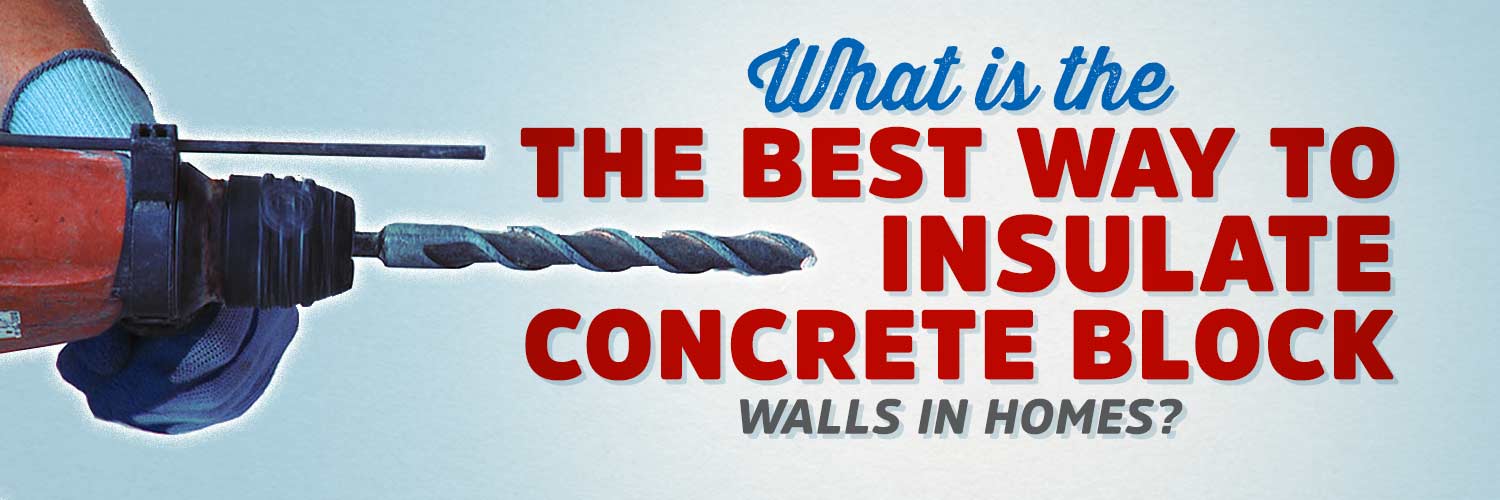What is the Best Way to Insulate Concrete Block Walls in Homes?


Whether you call them concrete block walls, cinder blocks, or cement block walls, they are porous, which means they can let outside air in, not to mention the openness inside the blocks themselves.
This means your home isn’t going to be comfortable no matter what time of year it is and you’re likely paying a ton of money for your monthly energy bills.
The best way to combat this airflow is to insulate those concrete block walls, but there are a few ways to do this. The choice is yours on which way you decide to go as you know best what is best for you and your home.
RetroFoam of Michigan understands the best way to insulate concrete block walls in your home because we started this company insulating concrete blocks more than 17 years ago.
As we continue to educate homeowners, like yourself, let’s take a look at some block wall insulation.
Block Wall Insulation
Depending on whether the concrete block walls will be covered or if the top of the wall is exposed can really change the way they are insulated.
The option for insulating concrete block walls includes spray foam insulation, injection foam insulation, polystyrene beads, foam boards, and loose-fill masonry insulation. While these are the options, again the material available to use depends on whether the walls will be covered, or the open top is exposed, like in a remodel or new build.
Here is what each material has to offer.
Spray Foam Insulation for Concrete Block Walls
Spray foam insulation works for insulating concrete block walls before the drywall has been put into place and the studs have been furred out about a quarter of an inch to a half-inch.
This is recommended so when the concrete walls are sprayed, the foam insulation can get behind the stud to prevent any thermal bridging.
Thermal bridging is an area of a building that has a significantly higher heat transfer than the surrounding materials resulting in an overall reduction in thermal insulation.
If you aren’t worried about the walls looking like they have been sprayed and just want the insulation to stop thermal bridging in your basement, then in those cases the drywall isn’t necessary.
Polystyrene Bead Cavity Wall Insulation
This is used more commonly when the concrete walls are open at the top.
That’s because the beads are poured into the open cavities of the blocks from the top. Therefore, the beads could already be found in your concrete walls from when your home was built.
This all sounds well and good, but this insulation material poses one problem.
Because it consists of loose polystyrene beads, if you need to cut into the blocks for any reason, all of the beads would come pouring out. Just picture what it looks like when you dump out marbles, but on a much larger scale.
Using Foam Board for Concrete Wall Insulation
You won’t get the same performance as spray foam applied to the wall, but some homeowners have used foam board on the exterior of the block before putting on their exterior finish.
So, you may be wondering how to attach foam board to a concrete wall.
On the backside of the foam board, apply foam board adhesive using either a utility knife or caulk gun. Then it's as easy as putting the panel in place on the block wall. You'll want to make sure that you use caulk on the seams to make sure there aren't any air leaks.
If the seams around the foam board aren’t properly sealed, you will still get air movement into your home.
In this case, you could also experience condensation problems as two different temperatures meet in the wall. This will lead to the growth of mold and mildew.
The seams can be sealed with tape or caulk to help reduce that air movement.
Loose-Fill Masonry Insulation
Loose-Fill Masonry insulation, or mineral loose-fill insulation is the equivalent of filling your concrete block walls with a sand-like material.
This insulation material is used when the top of the concrete block wall cavity is open, and the mixture is poured into the open cavities in the blocks.
Much like the polystyrene beads, if you were to cut into the blocks for any reason the powdery insulation would pour out. Picture if you will an hourglass filled with sand, and that’s what it will look like as the insulation pours out.
Another issue with this material is that it is hard to ensure that the open cavities are filled since you are pouring from the top. If there is something in the way causing resistance, then the material won’t make its way all throughout the block cavities, still allowing for airflow.
Filling Concrete Blocks with Injection Foam Insulation
Injection foam insulation is another option for filling concrete blocks, much like spray foam, that will create an air barrier in the concrete block walls.
This method is done for existing concrete block walls. Holes are drilled in the middle of the wall into the cavities left open by lining up the cores in the concrete blocks.
The benefit of the injection foam is that it will fill all of those cavities, and even the crevices left open when the walls were mortared together. When the mason is putting together these walls, they are mortaring the long sides of the block, leaving openings in the middle and shorter ends.
These openings allow for air movement, which is why injection foam is one of the best options for insulating concrete block walls. The foam fills all of the nooks and crannies, pushing into the cores, and creating an air seal that will stop any air movement.
Insulating Concrete Block Walls
There are a few options for insulating concrete block walls in new construction.
If you’re insulating the block walls in your existing home, your choices are more limited depending on your situation. This is why it’s important to have a conversation with your contractor to see what is going to be the best fit.
While spray foam and injection foam creates the continuous insulation that will create an air seal, it also tends to be more expensive. Mineral wool, polystyrene beads, and foam boards are a less expensive option, these materials still allow for some air movement.
If foam insulation seems more up your alley, check out the Learning Center on our website to learn more about the benefits and how it works.
Related Articles
What is the Best Way to Insulate Concrete Block Walls in Commercial Buildings?
Can You Use Spray Foam to Stop Basement and Foundation Leaks?
8 Things to Do When a Basement Floods
About Amanda Emery
Amanda previously has worked as a breaking news and crime reporter, TV news producer, and editor in Flint and Detroit. Throughout her career as a journalist, she has won several awards from The Society of Professional Journalists - Detroit Chapter and the Michigan Press Association. As part of the RetroFoam of Michigan family, Amanda uses her experience as a journalist to write content that will help educate homeowners on the benefits of foam insulation. When Amanda isn’t writing, she’s spending time with her husband and rescued huskies. She also loves knitting, making art, cooking, and hosting dinner and a movie night for friends and family.


